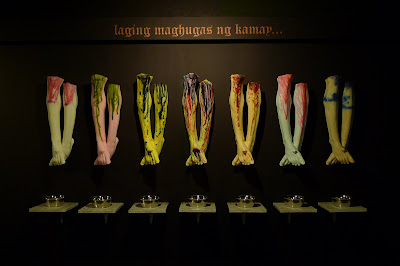
Sangkring Art Project
cordially invites you to the opening of
SAGE RESIDENCY #2: 'Yogyakarta'
Christopher H. Zamora (Philippines)
Josef Zean Cabangis (Philippines)
Choiruddin (Indonesia)
Nugroho Heri Cahyono (Indonesia)
Chong Kim Chiew (Malaysia)
Suddin Lappo (Malaysia)
Monday, 11 July 2011 at 07 pm
Dialogue & Artist Talk : Tuesday, 12 Juli 2011, Jam 16.00 wib
SAGE residensi 2011 : sebuah catatan ringkas
Yogyakarta, menjadi tempat singgah ke 2 program SAGE (Southeast Asia Group Exchange) Residensi 2011. Adalah sebuah program pertukaran seniman, program residensi, yang melibatkan kelompok seni visual dan perupa dari negara-negara di Asia Tenggara. Program ini bertujuan untuk menjalin hubungan sesama seniman, sekaligus membuka kesempatan untuk membangun jaringan kesenian di antara negara-negara yang terlibat. Program residensi ini digagas oleh Tenggara Artland (Indonesia), House of Matahati (Malaysia), Project Space Pilipinas (Philipina).
Menyertai mereka selama proses residensi, saya mencatat beberapa hal menarik dari proses kreatif yang telah dilakukan. Suasana Yogyakarta yang hiruk pikuk dengan kehidupan seni rupa, menjadi bagian menarik sepanjang pelaksanaan residensi. Lawatan ke studio seniman, menyaksikan event pembukaan pameran, obrolan dan diskusi bermalam-malam menjadi energi tersendiri. Wacana kesenian, market hingga perkara-perkara teknis penciptaan, menjadi bahan diskusi yang menarik untuk memahami kondisi medan seni rupa di negara masing-masing. Berpijak dari obrolan dan diskusi ini pula mereka mengancang karya-karya kolaborasi, di mana pertukaran gagasan, isu yang hendak dituju, pokok perupaan yang hendak dituangkan hingga pertimbangan material dan teknis penciptaan menjadi poin tersendiri. Kebiasan praktik kerja masing-masing seniman yang berlainan juga melahirkan negosiasi dan sharing kerja yang sangat menarik.
Menemani proses mereka berkarya, saya melihat ruh dan spirit yang sama dalam tajuk kekaryaan mereka, sebuah spirit dari masyarakat negara berkembang yang kritis dan terus bergeliat. Persoalan identifikasi diri, identitas, sejarah, akar kultur hingga persoalan modernitas dan globalisasi menjadi pertanyaan-pertanyaan kritis yang mereka lontarkan. Seperti Chong Kim Chiew menggunakan peta sebagai bahasa untuk mempertanyakan sejarah wilayah. Bagaimana kekuatan sosial politik, mampu merubah teritori, perbatasan hingga kontur demografis manusianya. Dengan media akrilik dan spidol boardmarker, ia pertemukan semua teks wilayah, jalan dan sungai, dan nama tempat dari seluruh wilayah dunia dalam selembar kertas. Carut marut tanda itulah yang menarik kita pada batas-batas memori akan ruang yang telah tererosi, sekaligus mengajak kita untuk menilik ulang konstruksi identitas. Ingatan akan kampung halamannya, Malaysia, menuntun Suddin Lappo untuk terus mengungkapkan kondisi negaranya saat ini. Bagaimana perjuangan rakyat Malaysia menegakkan demokrasi yang bersih disiratkannya dalam figur potret diri memegang kartu kuning. Warna yang identik dengan kompensasi pelanggaran dalam permainan sepak bola, di mana warna kuning juga menjadi simbol perjuangan rakyat Malaysia saat ini. Sebagai seniman, ia termasuk seniman yang kritis. Nada satire akan kebijakan negara berikut tingkah laku para aparatusnya seringkali tersemat dan terdengar dalam karya-karyanya.
Zean Cabangis, seniman muda dari Philipina ini banyak mencermati kontur lingkungan dari suatu tempat yang dikunjunginya, untuk kemudian disatukannya secara acak dalam bidang kanvas. Mulai dari figur, pohon, hingga benda-benda yang identik dengan tempat tersebut disusun dengan pendekatan teknik realism yang dipadu dengan corak-corak grafis sebagai elemen pendukung. Zean lebih banyak menyoal tentang identifikasi ruang berikut tegangannya dengan psikologi masyarakatnya, hingga respon audiens saat karya itu dipresentasikannya. Sementara Christopher Zamora asyik berkolaborasi dengan Nugroho Heri Cahyono. Persoalan globalisasi dan modernitas yang melanda dunia ketiga, telah menyebabkan masyarakatnya terkapar dengan kondisi ini. Konstruksi baja berbentuk diamond dimaksudkan sebagai ikon dari modernism, menindih sosok figur manusia yang menahannya tak berdaya. Seolah gambar bercerita, tubuh sang figure itupun layuh pada panel berikutnya. “Inilah gambaran masyarakat yang tidak sanggup menanggung beban modernitas dan globalisasi, mereka menyerah dan jatuh terkapar”, demikian ungkap Heri. Sementara persoalan art scene saat ini yang chaotic coba diungkapkan Choiruddin dalam potret seorang gadis yang dikelilingi buih. Samar-samar terlihat sobekan kertas bertulis ‘galeri’, suatu tanda yang mengundang konflik visual tersendiri. Apakah wacana art scene yang terkesan konseptualistik, molek dan cantik, hanyalah buih-buih basa yang hadir untuk menutupi kepentingan market yang sebenarnya?
Merangkai setiap gagasan visual dan pemikiran mereka, saya menangkap sebuah gajala kritis mereka atas perkembangan seni rupa kontemporer saat ini. Bagaimana seni kemudian hadir sebagai sebuah strategi diplomasi kebudayaan yang menarik, beririrng dengan perputaran kapital yang maha dahsyat. Bukan untuk menafikkannya, akan tetapi menjalin sebuah pemahaman bersama untuk kemudian bersikap kritis dan seksama. Ada sebuah strategi kesenian yang mesti dibangun secara bersama-sama, tidak saja dalah satu teritori, namun melintas sekat pembatas negara. Upaya kerja jaringan ini harus terus diupayakan dengan tetap berpijak pada identifikasi diri, meyakini identitas asal dan akar kultural serta menjalin kerja kolektif yang kontributif. Senyatanya setiap gagasan karya mereka mengancang pada persoalan identitas yang terbelah dan problematik. Setiap karya hadir dalam nuansa dan wacana yang dalam. Proses kerja mereka selama residensi menunjukkan karakter yang beragam. Layaknya sebuah motivasi, mencermati perspektif mereka terasa ad upaya identifikasi diri yang lebih, reposisi wacana kekinian, hingga upaya pemetaan posisi seni rupa kontemporer Asia Tenggara dalam peta seni dunia.
Program residensi SAGE ini merupakan sebuah program kerja jaringan yang sangat baik dalam membuka peluang komunikasi dan hubungan lintas budaya. Bagaimana seniman mampu membaca, memahami dan berkarya secara kontekstual di mana pun mereka berada. Adanya spirit akar rumpun yang sama juga memberikan motivasi yang menarik dalam melihat dan mencermati fenomena global yang ada. Berbincang dengan mereka senyatanya saya menangkap sebuah mimpi bersama, Asia Tenggara menjadi kiblat seni kontemporer dunia suatu hari nanti. (Hendra Himawan. kurator)
Organizer by
TENGGARA, House of MATAHATI (HOM), Project Space Pilipinas
Sangkring Art Project
Nitiprayan Rt.1 Rw.20 No. 88 Ngestiharjo, Kasihan Bantul Yogyakarta, 55182, Telp. (0274) 381032; 081227675678
The exhibition will continue until 23 July 2011



































